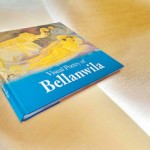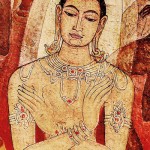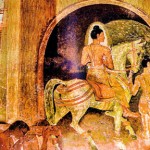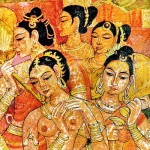Sunday Times 2
Poetic murals of Bellanwila: Landmark temple art
View(s):By Archaeology Director General Prof. Anura Manatunga
Bellanwila is one of the oldest Buddhist temples in the Western Province and its history goes back to the 3rd Century BCE. The historic Bodhi tree of the temple premises is believed to be one of the sacred thirty-two saplings of the Sri Maha Bodhi of Anuradhapura.
The second development phase of the temple can be traced to the Kotte period and the recent constructions have begun in the 19th Century. At present, Bellanwila is one of Sri Lanka’s most venerated and popular temples such as the temples in Kelaniya and Kalutara.
Renowned artist Somabandhu Vidyapathi’s modern paintings have given added value to the Bellanwila temple. Somabandhu started to draw the paintings in 1990 and completed the task in 1998. He was 75 when he finished the job. Somabandhu’s paintings cover a total area of 4,632 sq. ft on the temple walls. A coffee table book, containing those paintings will be launched on April 28 at the BM1CH in the presence of Viharadhipathi Ven. Bellanwila Dhammaratana Thera. He is the patron of the publication titled “Visual Poetry of Bellanwila”.
This illustrated book contains a large number of colour photographs of Somabandhu’s murals. They were captured by veteran photographer Lal Hegoda and his team. W.M.K. Wijayabandara and Charulatha Abeysekera Thewarathanthri have done a great job in designing the book and penning the script in poetic language. The postscript of Sarath Chandrajeewa well synthesises the history of the artistic tradition of Sri Lanka. He rightly pointed out the aesthetic value and stylistic uniqueness of Bellanwila murals among Sri Lankan paintings.
Somabandhu’s paintings recall a mixture of modern and traditional styles but he produced them in his own style unparallel to none. Colours, lines, gestures, backgrounds and the integrity of all elements make a totally different style which one may call “Somabandhu style” and which can be admired along with Solias Mendis and George Keyt, two well-known painters of the 20th Century with their own styles in mural painting.
The Bellanwila paintings may be cited as the latest example of the long tradition of mural paintings of Sri Lanka. The classical paintings of Sigiriya and Thivanka are the best-surviving examples of this tradition. The Kandy period paintings in temples such as the Dambulla, Degaldoruwa, Medawala and Gangarama viharas, having their own sub-styles, show a continuation of this tradition.
Unlike other temple painters, Somabandhu has not paid importance to Jathaka stories, though they contain some picturesque narrative scenes. His emphasis was on the important events in the life of the Gauthama Buddha and in the history of Buddhism. Queen Maya’s wondrous dream on the day she conceived Prince Siddhartha has been illustrated with the mythical white elephant and four guardian deities. The birth of Siddhartha at the Lumbini grove is placed below the scene and both can be taken as one picture. The tilling ceremony and miracles that happened with the infant Siddhartha are depicted in another picture. Learning arts and sciences by young Siddhartha has also been selected by the painter. Events related to the marriage of Princess Yasodhara, the four omens that led Siddhartha to understand the futility of worldly life, the birth of his son Rahula, and the Great Departure were given prominence in his painted story.
Also depicted are the Buddha’s journey as a recluse, his meeting with various teachers, his sufferings in the forest life, and his triumph over Mara.
The Buddha’s life from attaining supreme Buddhahood and Sujata’s offering of milk rice to the Maha Parinirvana or the great passing away are also subjects of Somabandhu’s paintings. The third Buddhist council and the Sanghamitta’s visit to Sri Lanka with a Bodhi sapling during Emperor Asoka’s time are also considered events worthy of being painted on the Vihara wall.
Somabandhu’s Bellanwila temple murals and the book “Visual Poems of Bellanwila” are landmarks in the history of Sri Lankan art. Sadly, these paintings and the painter came into existence after the time of great art critics, such as Ananda Coomaraswamy, Nandadewa Wijesekara, Siri Gunasinghe and Seneke Bandaranayake. Otherwise, Somabandhu and Bellanwila would have been given a prominent place in their classical works.





